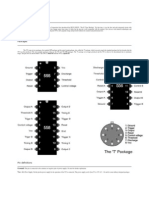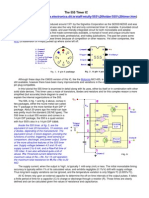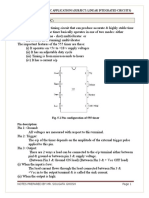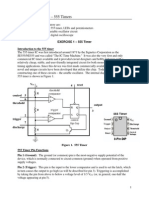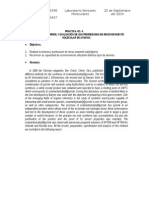6.1 IC555 TIMER: Circuit Components
6.1 IC555 TIMER: Circuit Components
Uploaded by
Manish PradhanCopyright:
Available Formats
6.1 IC555 TIMER: Circuit Components
6.1 IC555 TIMER: Circuit Components
Uploaded by
Manish PradhanOriginal Title
Copyright
Available Formats
Share this document
Did you find this document useful?
Is this content inappropriate?
Copyright:
Available Formats
6.1 IC555 TIMER: Circuit Components
6.1 IC555 TIMER: Circuit Components
Uploaded by
Manish PradhanCopyright:
Available Formats
CIRCUIT COMPONENTS 6.
1 IC555 TIMER
DESCRIPTION The 555 timer IC was first introduced around 1971 by the Signetics Corporation as the SE555/NE555 and was called "The IC Time Machine" and was also the very first and only commercial timer IC available. The 555 is a monolithic timing circuit that can produce accurate and highly stable time delays or oscillations. It has an adjustable duty cycle ,timing is from microseconds to hours. It has a high current output ,it can source or sink 200 miliamperes . It can operate in one of the two modes either as a monostable (one-shot) multivibrator or as an astable (free running) multivibrator .It can be used in dc-dc converters, digital logic probes, waveform generators, analog frequency meters and tachometers, temperature measurement and control ,infrared transmitters ,burglar and toxic gas alarms ,voltage regulators ,electric eyes and many others.
THE 555 INTERNAL CIRCUITS
PIN OUT The 555 comes in 2 packages, either the round metal-can called the 'T' package or the more familiar 8-pin DIP 'V' package. The 556 timer is a dual 555 version and comes in a 14-pin DIP package, the 558 is a quad version with four 555's also in a 14 pin DIP package.
PIN DESCRIPTION Pin1: Ground. All voltages are measured with respect to this terminal. Pin2: Trigger. The output of the timer depends on the amplitude of the external trigger pulse applied to this pin. The output is low if the voltage at this pin is greater than 2/3 VCC. When a negative going pulse of amplitude greater than 1/3 VCC is applied to this pin, comparator 2 output goes low, which in turn switches the output of the timer high. The output remains high as long as the trigger terminal is held at a low voltage. Pin3: Output. There are two ways by which a load can be connected to the output terminal: either between pin 3 and ground or between pin 3 and supply voltage +VCC. When the output is low the load current flows through the load connected between pin 3 and +VCC into the output terminal and is called sink current. The current through the grounded load is zero when the output is low. For this reason the load connected between pin 3 and +VCC is called the normally on load and that connected between pin 3 and ground is called normally off-load. On the other hand, when the output is high the current through the load connected between pin 3 and +VCC is zero. The output terminal supplies current to the normally off load. This current is called source current. The maximum value of sink or source current is 200mA. Pin4: Reset. The 555 timer can be reset (disabled) by applying a negative pulse to this pin. When the reset function is not in use, the reset terminal should be connected to +VCC to avoid any possibility of false triggering. Pin5: Control Voltage. An external voltage applied to this terminal changes the threshold as well as trigger voltage. Thus by imposing a voltage on this pin or by connecting a pot between this pin and ground, the pulse width of the output waveform can be varied. When not used, the control pin should be bypassed to ground with a 0.01F Capacitor to prevent any noise problems. Pin6: Threshold. This is the non-inverting input of comparator 1, which monitors the voltage across the external capacitor. When the voltage at this pin is greater than or equal to the threshold voltage 2/3 VCC, the output of comparator 1 goes high, which in turn switches the output of the timer low.
Pin7: Discharge. This pin is connected internally to the collector of transistor Q1. When the output is high Q1 is OFF and acts as an open circuit to external capacitor C connected across it. On the other hand, when the output is low, Q1 is saturated and acts as a short circuit, shorting out the external capacitor C to ground. Pin8: +VCC. The supply voltage of +5V to + 18V is applied to this pin with respect to ground.
OPERATION Initially when the circuit is in the stable state i.e , when the output is low, transistor Q1 is ON and the capacitor C is shorted to ground. Upon the application of a negative trigger pulse to pin 2, transistor Q1 is turned OFF, which releases the short circuit across the external capacitor C and drives the output high. The capacitor C now starts charging up towards VCC through R. When the voltage across the capacitor equals 2/3 VCC, comparator 1s output switches from low to high, which in turn drives the output to its low state via the output of the flip-flop. At the same time the output of the flip-flop turns transistor Q1 ON and hence the capacitor C rapidly discharges through the transistor. The output of the monostable remains low until a trigger pulse is again applied. Then the cycle repeats. The pulse width of the trigger input must be smaller than the expected pulse width of the output waveform. Also the trigger pulse must be a negative going input signal with amplitude larger than 1/3 VCC. The time during which the output remains high is given by T= 1.1 RC seconds. Where R is in Ohms and C is in Farads. Once triggered, the circuits output will remain in the high state until the set time, T elapses. The output will not change its state even if an input trigger is applied again during this time interval T. The circuit can be reset during the timing cycle by applying negative pulse to the reset terminal. The output will remain in the low state until a trigger is again applied.
OPERATING MODES The 555 timer has two basic operational modes: one shot and astable. In the oneshot mode, the 555 acts like a monostable multivibrator. A monostable is said to have a single stable state--that is the off state. Whenever it is triggered by an input pulse, the monostable switches to its temporary state. It remains in that state for a period of time determined by an RC network. It then returns to its stable state. In other words, the monostable circuit generates a single pulse of fixed time duration each time it receives and input trigger pulse. Thus the name one-shot. One-shot multivibrators are used for turning some circuit or external component on or off for a specific length of time. It is also used to generate delays. When multiple oneshots are cascaded, a variety of sequential timing pulses can be generated. MONOSTABLE OPERATION In the basic circuit of the 555 connected as a monostable multivibrator an external RC network is connected between the supply voltage and ground. The junction of the resistor and capacitor is connected to the threshold input which is the input to the upper comparator. The internal discharge transistor is also connected to the junction of the resistor and the capacitor. An input trigger pulse is applied to the trigger input, which is the input to the lower comparator. With that circuit configuration, the control flip-flop is initially reset. Therefore, the output voltage is near zero volts. The signal from the control flip-flop causes T1 to conduct and act as a short circuit across the external capacitor. For that reason, the capacitor cannot charge. During that time, the input to the upper comparator is near zero volts causing the comparator output to keep the control flip-flop reset.
ASTABLE OPERATION The other basic operational mode of the 555 is as astable multivibrator. An astable multivibrator is simply an oscillator. The astable multivibrator generates a continuous stream of rectangular off-on pulses that switch between two voltage levels. The frequency of the pulses and their duty cycle are dependent upon the RC network values.
Fig shows the 555 connected as an astable multivibrator. Both the trigger and threshold inputs to the two comparators are connected together and to the external capacitor. The capacitor charges toward the supply voltage through the two resistors, R1 and R2. The discharge pin (7) connected to the internal transistor is connected to the junction of those two resistors. When power is first applied to the circuit, the capacitor will be uncharged; therefore, both the trigger and threshold inputs will be near zero volts. The lower comparator sets the control flip-flop causing the output to switch high. That also turns off transistor T1. That allows the capacitor to begin charging through R1 and R2. As soon as the charge on the capacitor reaches 2/3 of the supply voltage, the upper comparator will trigger causing the flip-flop to reset. That causes the output to switch low. Transistor T1 also conducts. The effect of T1 conducting causes resistor R2 to be connected across the external capacitor. Resistor R2 is effectively connected to ground through internal transistor T1. The result of that is that the capacitor now begins to discharge through R2.The voltage across the capacitor reaches 1/3 of the supply voltage, the lower comparator is triggered. The control flip-flop to set and the output to go high.T1 cuts off and again the capacitor begins to charge. The cycle continues to repeat with the capacitor alternately charging
and discharging, as the comparators cause the flip-flop to be repeatedly set and reset. The resulting output is a continuous stream of rectangular pulses. The frequency of operation of the astable circuit is dependent upon the values of R1, R2, and C. The frequency can be calculated with the formula: f = 1/ (.693 x C x (R1 + 2 x R2)) The Frequency f is in Hz, R1 and R2 are in ohms, and C is in farads. The time duration between pulses is known as the 'period', and usually designated with at. The pulse is on for t1 seconds, then off for t2 seconds. The total period (t) is t1 + t2 . The time intervals for the on and off portions of the output depend upon the values of R1 and R2. The ratio of the time duration when the output pulse is high to the total period is known as the duty-cycle. The duty-cycle can be calculated with the formula: D = t1/t = (R1 + R2) / (R1 + 2R2) You can calculate t1 and t2 times with the formulas below: t1 = .693(R1+R2)C t2 = .693 x R2 x C The 555 can produce duty-cycles in the range of approximately 55 to 95%. A duty-cycle of 80% means that the output pulse is on or high for 80% of the total period.
6.2 IR LIGHT EMITTING DIODES (LEDs):
Function: IR LEDs emit infrared light when forward biased. Circuit symbol:
There are a couple key differences in the electrical characteristics of infrared LEDs versus visible light LEDs. Infrared LEDs have a lower forward voltage, and a higher rated current compared to visible LEDs. This is due to differences in the material properties of the junction. A typical drive current for an infrared LED can be as high as 50 milliamps, so dropping in a visible LED as a replacement for an infrared LED could be a problem with some circuit designs. THERMAL RUN-AWAY When a junction gets warmer, the current through it at a given voltage will increase. The increased current in turn heats the junction further, and the problem gets worse. Eventually, if nothing limits the current, the junction will fail due to the heat. Because of thermal runaway, its important to use some current limiting circuit even with a regulated voltage source.
You might also like
- Trinity College Cambridge Maths Interview TestDocument2 pagesTrinity College Cambridge Maths Interview TestJackson Leung50% (2)
- Dewatering 3Document4 pagesDewatering 3Mohamed HizamNo ratings yet
- Operation 555 Timer/OscillatorDocument7 pagesOperation 555 Timer/OscillatoryuvakiraniNo ratings yet
- 555 Timer Integrated CircuitDocument8 pages555 Timer Integrated CircuitTalha WaqarNo ratings yet
- SE/NE 555 Timer. It Is Basically A Monolithic Timing Circuit That Produces Accurate and Highly Stable Time Delays orDocument12 pagesSE/NE 555 Timer. It Is Basically A Monolithic Timing Circuit That Produces Accurate and Highly Stable Time Delays orEFraim Manzano FranciscoNo ratings yet
- The Important Features of The 555 Timer AreDocument7 pagesThe Important Features of The 555 Timer ArePathella SudhakarNo ratings yet
- 555 Timer IC: The Important Features of The 555 Timer AreDocument5 pages555 Timer IC: The Important Features of The 555 Timer AreChara GalaNo ratings yet
- IC 555 Multivibrator CircuitsDocument11 pagesIC 555 Multivibrator CircuitsKaran YadavNo ratings yet
- List The Features of 555 TimersDocument3 pagesList The Features of 555 TimersDivyesh DivakarNo ratings yet
- LIC Mod 2Document15 pagesLIC Mod 2Sona PrakashNo ratings yet
- Timer 555 - ManualDocument20 pagesTimer 555 - ManualXen XeonNo ratings yet
- Lab#10: Design and Study of IC 555 Multivibrator Circuits (2 Turns)Document11 pagesLab#10: Design and Study of IC 555 Multivibrator Circuits (2 Turns)Ayushman ChoudharyNo ratings yet
- LIC - Unit III-NotesDocument21 pagesLIC - Unit III-Notesmuhammedasifpc30No ratings yet
- UNIT-4 Special Ics The 555 Timer IcDocument10 pagesUNIT-4 Special Ics The 555 Timer IcVerloves LoveNo ratings yet
- 3.1555 TIMER:: Schematic SymbolDocument10 pages3.1555 TIMER:: Schematic SymbolnagpradasNo ratings yet
- Multivibrator CircuitsDocument11 pagesMultivibrator CircuitsSatyaki ChowdhuryNo ratings yet
- 555 Timer IC-Block Diagram-Working-Pin Out Configuration-Data SheetDocument13 pages555 Timer IC-Block Diagram-Working-Pin Out Configuration-Data SheetΔημητριος ΣταθηςNo ratings yet
- IC555 TimerDocument8 pagesIC555 TimerRaflysyah PutraNo ratings yet
- Multivibrador Com Ci 555Document11 pagesMultivibrador Com Ci 555joselito1juniorNo ratings yet
- Opamp Applicationpart30Document31 pagesOpamp Applicationpart30KUNTALA DASNo ratings yet
- 555 Timer: by D.V.Kamat, Faculty Department of E&C Engg., MITDocument21 pages555 Timer: by D.V.Kamat, Faculty Department of E&C Engg., MITRupsa SahaNo ratings yet
- IC 555 TimerDocument6 pagesIC 555 Timeraditya pandeyNo ratings yet
- Presentation On Ic 555 Timer: BY: Sandeep KumarDocument24 pagesPresentation On Ic 555 Timer: BY: Sandeep KumarSandeep Kamti BrzeeNo ratings yet
- Monostable MultivibratorDocument4 pagesMonostable MultivibratorSakshi GosaviNo ratings yet
- 555Document80 pages555elpasanteNo ratings yet
- ElectronicIII - L3Document14 pagesElectronicIII - L3Aya MazinNo ratings yet
- unit 3Document52 pagesunit 3sumeetzope68No ratings yet
- 4 555timer 120916082406 Phpapp02Document14 pages4 555timer 120916082406 Phpapp02sunil1237No ratings yet
- Ic 555Document25 pagesIc 555Ahmed SaȜed El-HadyNo ratings yet
- 555 Integrated Circuit (Timer Operation)Document5 pages555 Integrated Circuit (Timer Operation)Geet SehgalNo ratings yet
- 9 555 TimerDocument24 pages9 555 TimerPankajJangraNo ratings yet
- 555 IcDocument7 pages555 IcEngr Wahab MarwatNo ratings yet
- 555 Timers Modi12Document21 pages555 Timers Modi12jewixe8466No ratings yet
- Multi VibratorDocument3 pagesMulti Vibratorsayan.pal.23No ratings yet
- 555 Timer Lecture and Lab4Document3 pages555 Timer Lecture and Lab4litogabo9No ratings yet
- The 555 Timer IC (Adapted From) : CaseDocument12 pagesThe 555 Timer IC (Adapted From) : CaseBiswajit Sarkar100% (1)
- Ci 555Document25 pagesCi 555Cristian VacaNo ratings yet
- Integratedelectronics (Unit2) 555 TIMER ASTABLE MONOSTABLE MVDocument5 pagesIntegratedelectronics (Unit2) 555 TIMER ASTABLE MONOSTABLE MVYogeshwaranNo ratings yet
- NE 555 ConvertedDocument46 pagesNE 555 Convertedshehansanjeewa822No ratings yet
- Ic Applications Lab NewDocument12 pagesIc Applications Lab NewSandy RonaldoNo ratings yet
- Lic Eec-501 Notes Unit5 Iftm UniversityDocument14 pagesLic Eec-501 Notes Unit5 Iftm UniversitySougata GhoshNo ratings yet
- ME 455/555 - Lab 2 - 555 TimersDocument10 pagesME 455/555 - Lab 2 - 555 TimersGustavo KernNo ratings yet
- 555 Timer - Oscillator TutorialDocument14 pages555 Timer - Oscillator TutorialfgaluppoNo ratings yet
- 555 Timer ICDocument20 pages555 Timer ICDivey PradhanNo ratings yet
- 555 Timer ExplainedDocument27 pages555 Timer ExplainedThe Lost WolfNo ratings yet
- Introduction To IC 555 TimerDocument66 pagesIntroduction To IC 555 TimermuraliNo ratings yet
- 1 Ic 555Document6 pages1 Ic 555Harish PatilNo ratings yet
- 555 TimerDocument3 pages555 TimerchandrakanthNo ratings yet
- E.C.E - 210Document18 pagesE.C.E - 210xxkkassNo ratings yet
- University of Engineering and Technology, Lahore Department of Electrical EngineeringDocument5 pagesUniversity of Engineering and Technology, Lahore Department of Electrical EngineeringMuhammad SameerNo ratings yet
- University of Engineering and Technology, Lahore Department of Electrical EngineeringDocument5 pagesUniversity of Engineering and Technology, Lahore Department of Electrical EngineeringMuhammad SameerNo ratings yet
- N555e Intergrated CircuitDocument6 pagesN555e Intergrated CircuitGeorge Boman SethNo ratings yet
- MultivibratorsDocument6 pagesMultivibratorsWaseem AkramNo ratings yet
- Schmitt Inverter Waveform GeneratorDocument40 pagesSchmitt Inverter Waveform GeneratorsaravananNo ratings yet
- Chapter 16Document6 pagesChapter 16Tấn NguyễnNo ratings yet
- 555 TimerDocument76 pages555 TimerSai Krishna KodaliNo ratings yet
- MUltivibratorsDocument15 pagesMUltivibratorsTēmptēd Êģŏişitiç ßērrýx ÐxNo ratings yet
- Tutorial Timmer 555Document9 pagesTutorial Timmer 555gabrielamedeletNo ratings yet
- Bab 4 - Timer 555 (Update)Document31 pagesBab 4 - Timer 555 (Update)NUR FATHIAH BINTI ABDUL HALIM STUDENTNo ratings yet
- Unit 5Document59 pagesUnit 5vbarath58No ratings yet
- Reference Guide To Useful Electronic Circuits And Circuit Design Techniques - Part 2From EverandReference Guide To Useful Electronic Circuits And Circuit Design Techniques - Part 2No ratings yet
- Síntesis de Calix (4) PirrolDocument5 pagesSíntesis de Calix (4) PirrolFelipe De Gante100% (1)
- 263 - PH8151-Engineering Physics - Question BankDocument11 pages263 - PH8151-Engineering Physics - Question BankBerentoNo ratings yet
- Simple Improvement of Momentum Interpolation Equation For Navier Stokes Equation Solver On Unstructured GridDocument6 pagesSimple Improvement of Momentum Interpolation Equation For Navier Stokes Equation Solver On Unstructured GridMuhammad IrfanNo ratings yet
- Liceo de Apodaca Miguel Leon Tavizón ElectricityDocument8 pagesLiceo de Apodaca Miguel Leon Tavizón ElectricityMiguel Leon TavizonNo ratings yet
- Rheometry: Introduction To The Rheology of Complex FluidsDocument63 pagesRheometry: Introduction To The Rheology of Complex FluidsCristian Miguel Gutierrez CuervoNo ratings yet
- Rotational MotionDocument6 pagesRotational Motionkunalsingh4766No ratings yet
- Saurabh Kesarwani 0806931079 E.C. 3 YearDocument18 pagesSaurabh Kesarwani 0806931079 E.C. 3 YearSaurabh KesarwaniNo ratings yet
- Physics Investigatory ProjectDocument5 pagesPhysics Investigatory ProjectNisaar Jogi50% (2)
- Linear AlgebraDocument545 pagesLinear Algebramatty_yomoNo ratings yet
- Students ObservationDocument94 pagesStudents ObservationGautami SumanNo ratings yet
- Black HolesDocument47 pagesBlack HolesSophie RusselNo ratings yet
- Static FrictionDocument2 pagesStatic Frictionjacob_murilloNo ratings yet
- wph14 01 Que 20230531Document32 pageswph14 01 Que 20230531umm100% (1)
- St. Joseph's Residential School, Sriperumbudur, Chennai-602 105Document18 pagesSt. Joseph's Residential School, Sriperumbudur, Chennai-602 105MSD PrajwalNo ratings yet
- 7-Unit8 Electricity and MagnetismDocument33 pages7-Unit8 Electricity and Magnetismelty Tan100% (1)
- A Brief Primer On Dark MatterDocument6 pagesA Brief Primer On Dark MatterIndrajit KamalanathanNo ratings yet
- 671c70ad6dc441bf176983d1 62798591469Document2 pages671c70ad6dc441bf176983d1 62798591469Alaa ChaouaNo ratings yet
- Estimation of Plotting Position For Flood Frequency AnalysisDocument10 pagesEstimation of Plotting Position For Flood Frequency AnalysisEng Venance MasanjaNo ratings yet
- Gr10 PS P2 (ENG) June 2022 Question PaperDocument11 pagesGr10 PS P2 (ENG) June 2022 Question Paperjoyceek77No ratings yet
- Inorganic Chemistry: Chemistry of Transition ElementsDocument44 pagesInorganic Chemistry: Chemistry of Transition ElementsDhanushka Warnakulasooriya100% (1)
- SSC Combined Graduate Level Exam 2011: General AwarenessDocument8 pagesSSC Combined Graduate Level Exam 2011: General AwarenessManish SinghNo ratings yet
- 275 Differential Equations Student Solution Manual1Document748 pages275 Differential Equations Student Solution Manual1Cristino Castro0% (1)
- Magneto-Optics: Presented By: ARIF Lubna ANIK IstiaqDocument27 pagesMagneto-Optics: Presented By: ARIF Lubna ANIK IstiaqIstiaq Ahmed AnikNo ratings yet
- 8493506Document117 pages8493506Nessha PavithranNo ratings yet
- Bernecker Supports With Estimated Dimensions For QuantitiesDocument6 pagesBernecker Supports With Estimated Dimensions For QuantitiesEngr Tahir UL HaqNo ratings yet
- Full Download Elastic Waves in Solids 1 Propagation 1st Edition Daniel Royer PDF DOCXDocument50 pagesFull Download Elastic Waves in Solids 1 Propagation 1st Edition Daniel Royer PDF DOCXrallyskuttpp100% (3)
- Силабус ФизикаDocument12 pagesСилабус ФизикаAruzhan egizbaiNo ratings yet































